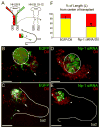Neuropilin-1 interacts with the second branchial arch microenvironment to mediate chick neural crest cell dynamics
- PMID: 20503363
- PMCID: PMC3077279
- DOI: 10.1002/dvdy.22303
Neuropilin-1 interacts with the second branchial arch microenvironment to mediate chick neural crest cell dynamics
Abstract
Cranial neural crest cells (NCCs) require neuropilin signaling to reach and invade the branchial arches. Here, we use an in vivo chick model to investigate whether the neuropilin-1 knockdown phenotype is specific to the second branchial arch (ba2), changes in NCC behaviors and phenotypic consequences, and whether neuropilins work together to facilitate entry into and invasion of ba2. We find that cranial NCCs with reduced neuropilin-1 expression displayed shorter protrusions and decreased cell body and nuclear length-to-width ratios characteristic of a loss in polarity and motility, after specific interaction with ba2. Directed NCC migration was rescued by transplantation of transfected NCCs into rhombomere 4 of younger hosts. Lastly, reduction of neuropilin-2 expression by shRNA either solely or with reduction of neuropilin-1 expression did not lead to a stronger head phenotype. Thus, NCCs, independent of rhombomere origin, require neuropilin-1, but not neuropilin-2 to maintain polarity and directed migration into ba2.
Figures





Similar articles
-
In vivo analysis reveals a critical role for neuropilin-1 in cranial neural crest cell migration in chick.Dev Biol. 2007 Jan 1;301(1):227-39. doi: 10.1016/j.ydbio.2006.08.019. Epub 2006 Aug 10. Dev Biol. 2007. PMID: 16959234
-
Vascular endothelial growth factor (VEGF) regulates cranial neural crest migration in vivo.Dev Biol. 2010 Mar 1;339(1):114-25. doi: 10.1016/j.ydbio.2009.12.022. Epub 2009 Dec 28. Dev Biol. 2010. PMID: 20036652 Free PMC article.
-
Neuropilins define distinct populations of neural crest cells.Neural Dev. 2014 Nov 3;9:24. doi: 10.1186/1749-8104-9-24. Neural Dev. 2014. PMID: 25363691 Free PMC article.
-
Cranial neural crest migration: new rules for an old road.Dev Biol. 2010 Aug 15;344(2):543-54. doi: 10.1016/j.ydbio.2010.04.010. Epub 2010 Apr 23. Dev Biol. 2010. PMID: 20399765 Free PMC article. Review.
-
Patterning the neural crest derivatives during development of the vertebrate head: insights from avian studies.J Anat. 2005 Nov;207(5):447-59. doi: 10.1111/j.1469-7580.2005.00485.x. J Anat. 2005. PMID: 16313387 Free PMC article. Review.
Cited by
-
Single-cell transcriptome analysis of avian neural crest migration reveals signatures of invasion and molecular transitions.Elife. 2017 Dec 4;6:e28415. doi: 10.7554/eLife.28415. Elife. 2017. PMID: 29199959 Free PMC article.
-
FOXO1-mediated activation of Akt plays a critical role in vascular homeostasis.Circ Res. 2014 Jul 7;115(2):238-251. doi: 10.1161/CIRCRESAHA.115.303227. Epub 2014 May 29. Circ Res. 2014. PMID: 24874427 Free PMC article.
-
Angiopoietin 2 signaling plays a critical role in neural crest cell migration.BMC Biol. 2016 Dec 15;14(1):111. doi: 10.1186/s12915-016-0323-9. BMC Biol. 2016. PMID: 27978830 Free PMC article.
-
Chick cranial neural crest cells release extracellular vesicles that are critical for their migration.J Cell Sci. 2022 Jun 15;135(12):jcs260272. doi: 10.1242/jcs.260272. Epub 2022 Jun 28. J Cell Sci. 2022. PMID: 35635292 Free PMC article.
-
Visualizing mesoderm and neural crest cell dynamics during chick head morphogenesis.Dev Biol. 2020 May 15;461(2):184-196. doi: 10.1016/j.ydbio.2020.02.010. Epub 2020 Feb 19. Dev Biol. 2020. PMID: 32084354 Free PMC article.
References
-
- Baker CV, Bronner-Fraser M. The origins of the neural crest. Part I: embryonic induction. Mech Dev. 1997;69:3–11. - PubMed
-
- Bron R, Eickholt BJ, Vermeren M, Fragale N, Cohen J. Functional knockdown of neuropilin-1 in the developing chick nervous system by siRNA hairpins phenocopies genetic ablation in the mouse. Dev Dyn. 2004;230:299–308. - PubMed
Publication types
MeSH terms
Substances
Grants and funding
LinkOut - more resources
Full Text Sources

